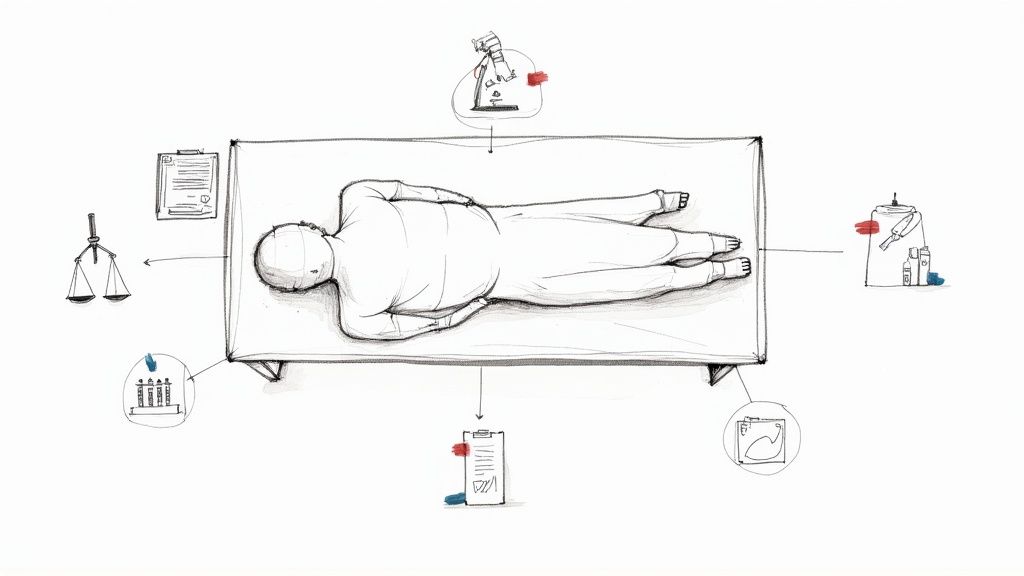When a person dies unexpectedly, suddenly, or under unclear circumstances, the first question is always, "What happened?" As a forensic pathologist, my entire profession is dedicated to answering that question with scientific certainty. A forensic autopsy is a specialized medical-legal examination designed to determine the cause and manner of death for legal and public health purposes.
It's a process far removed from what is often depicted in popular media. It is a meticulous, scientific investigation that provides objective answers for families, law enforcement, and the justice system when they are most needed. While a hospital autopsy generally looks inward to understand a known disease, a forensic autopsy looks outward to understand the complete circumstances surrounding a death.
- TL;DR: A forensic autopsy is a legally mandated medical examination performed after a sudden, unexpected, or violent death to determine the cause and manner of death.
- It is a meticulous, scientific procedure focused on evidence collection for legal and public health purposes.
- Unlike a clinical autopsy, it does not require family consent and its findings are official legal evidence.
- The process involves a detailed external examination, an internal examination, and ancillary studies like toxicology.
- The final autopsy report provides definitive, factual answers for families and the justice system.
The Purpose of a Forensic Autopsy
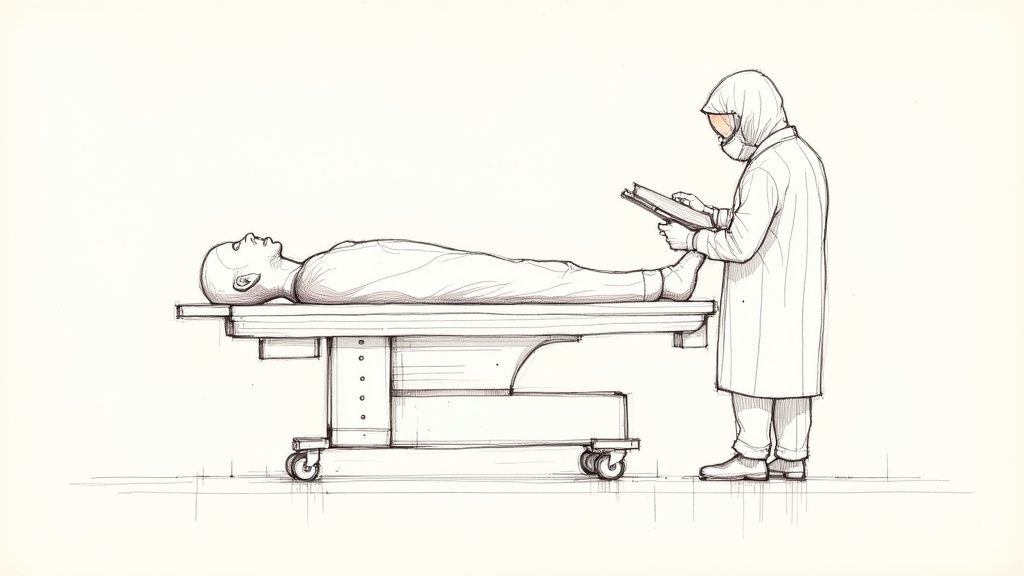
In my work, I often meet families on the most difficult day of their lives. In the midst of shock and grief, what they seek are clear, honest answers. That is the fundamental purpose of a forensic autopsy—to provide truth, delivered with scientific precision and profound respect for the person who has passed.
This examination is the foundation of any thorough death investigation. It is not merely a medical procedure; it is a careful search for facts, guided by compassion and objectivity, that brings clarity when everything feels uncertain.
How a Forensic Autopsy Differs from a Clinical Autopsy
It is essential to understand that a forensic autopsy and a clinical (or hospital) autopsy are distinct procedures with very different goals. For families navigating this difficult time, knowing the difference is key to understanding what is happening.
Here is a simple breakdown:
Forensic vs. Clinical Autopsy: Key Differences
| Aspect | Forensic Autopsy | Clinical (Hospital) Autopsy |
|---|---|---|
| Primary Goal | Determine cause & manner of death for legal purposes. | Understand the extent of a known disease or treatment effects. |
| Consent | Legally mandated; family consent is not required. | Requires explicit consent from the next of kin. |
| Focus | Identification, injuries, external evidence, and toxicology. | Internal organs, disease progression, and medical history. |
| Trigger | Suspicious, violent, sudden, or unexplained deaths. | Deaths from known natural causes, often for research or closure. |
| Legal Standing | Findings are official evidence used in court proceedings. | Findings are for medical records and family understanding only. |
In essence, a clinical autopsy serves as a medical review, while a forensic autopsy is an official investigation.
The forensic autopsy plays a critical dual role. As a medical investigation, it provides definitive answers to a grieving family. As a legal tool, it ensures the facts of a death are accurately recorded for the justice system.
The examination creates an official, scientific record of what transpired, establishing an unbiased timeline and providing evidence that can answer questions for years to come. This careful, methodical process is the core of forensic pathology, a field dedicated to uncovering the truth with integrity. My goal is to replace speculation with certainty. Whether for a family searching for peace of mind or a court seeking justice, the forensic autopsy provides the foundation of facts needed to build sound conclusions. It is a vital service that honors the deceased by ensuring their final story is told accurately and completely.
The Origins of Modern Forensic Science
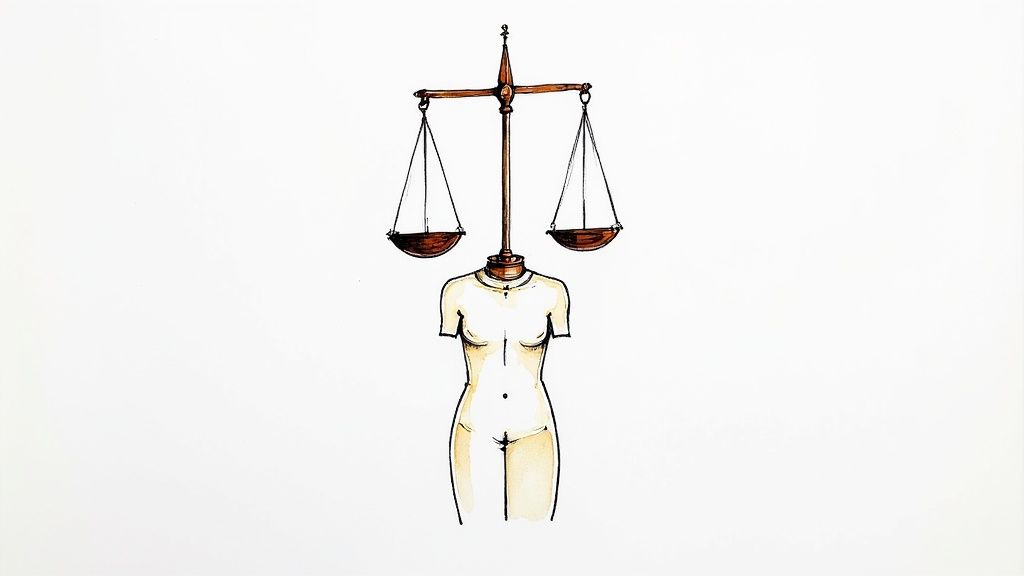
To appreciate the modern forensic autopsy, it helps to know that this is not a new invention. It is a practice refined over centuries, built on a timeless human need to find the truth following a death.
Even the earliest post-mortem examinations, while basic, were driven by the same questions we ask today. What happened here? Was this death natural, or did something else occur?
From Ancient Inquiry to Modern Precision
The real turning point came when physicians began documenting their findings. In 1302, a physician in Bologna, Italy, named Bartolomeo da Varignana conducted what many consider the first documented forensic autopsy. This marked a monumental shift from simple curiosity to a methodical, recorded search for answers.
At its heart, forensic pathology grew from a simple, powerful idea: the body is a source of objective evidence. The pioneers of this field took that concept and built a structured, scientific discipline around it, one that serves both medicine and the law.
This long, rich history has sharpened our methods, but our core mission has never wavered. We are here to provide clear, objective answers with compassion and care.
A Tradition of Seeking Truth
As time progressed, tremendous advances in medicine, chemistry, and technology equipped pathologists with incredible new tools. This evolution transformed the field from relying solely on what the eye could see to a highly specialized science that can identify microscopic clues and faint traces of toxins.
This journey from historical inquiry to modern science highlights just how vital this work is. It’s a discipline founded on a legacy of careful, rigorous investigation. For a different look at how investigative work has evolved, you might find The History Of Private Investigators In The Uk interesting.
Understanding this background helps frame what is a forensic autopsy today—not just as a procedure, but as the culmination of a long and honored tradition of medical-legal investigation.
Why a Forensic Autopsy Becomes Necessary
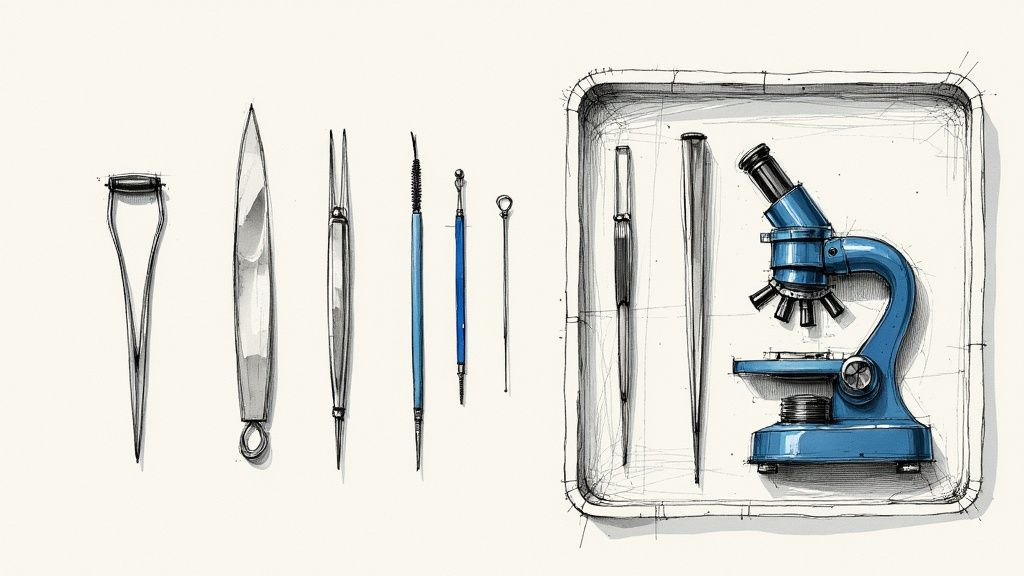
During a time of intense grief and confusion, one of the most jarring things a family can hear is that an autopsy is required by law. It is a decision that can feel sudden and invasive. I want to assure you, it is a step never taken lightly.
A forensic autopsy becomes a legal necessity when the circumstances surrounding a death are not straightforward or natural. It is a methodical, standard procedure designed to protect public health, ensure justice is served, and provide definitive answers. The decision is made by a medical examiner or justice of the peace, who has a statutory duty to investigate any death not clearly from natural causes.
Common Triggers for a Medico-Legal Examination
The legal framework is designed to ensure that deaths involving any uncertainty or potential foul play are thoroughly investigated. While specifics may differ by jurisdiction, the core reasons for mandating a forensic autopsy are always centered on finding the truth.
This procedure is typically required in cases such as:
- Homicides or suspected violence: Any time foul play is a possibility, a detailed examination is needed to gather evidence.
- Accidents and unexpected injuries: This includes everything from motor vehicle collisions and falls to drownings or workplace incidents where trauma caused death.
- Suicides: An autopsy provides official confirmation of the cause of death and helps rule out other contributing factors.
- Sudden or unexplained deaths: When a person who appeared healthy dies without a clear medical reason, a forensic autopsy is crucial.
- Deaths occurring in custody: This applies to anyone in jail, prison, or police custody, ensuring complete transparency and accountability.
The core purpose of a legally mandated autopsy is to serve as an impartial fact-finding mission. It provides an objective, scientific record that speaks for the deceased, offering clarity for their family and evidence for the justice system.
The Role of Evidence in Legal Proceedings
The findings from a forensic autopsy are far more than medical notes; they are critical pieces of evidence that can shape legal outcomes. This is especially true in investigations involving felony charges, where knowing the exact cause and manner of death is essential. The detailed documentation of injuries, collection of toxicology samples, and the pathologist's final assessment build the foundation for the legal process that follows.
Interestingly, the overall rate of autopsies has declined from approximately 25% to 35% in the mid-1960s to about 7% to 9% today. This is largely due to advancements in diagnostic technology that can often determine a cause of death without an invasive procedure.
However, when a death has legal implications, the forensic autopsy remains an irreplaceable tool for uncovering the truth. Ultimately, the process is about replacing doubt with documented facts.
If you are looking for more detail on specific situations that lead to this procedure, our guide on when autopsies are performed offers additional context.
Inside the Forensic Autopsy Process
When families hear a forensic autopsy is needed, their minds often go to what they have seen on television. The reality is much quieter, more methodical, and rooted in a deep respect for the person who has passed away. A forensic autopsy is not a single event; it is a careful, multi-stage process where each step is designed to uncover another piece of the puzzle.
As a forensic pathologist, my role is that of a medical detective. My duty is to be objective and to meticulously document every detail. It is a scientific investigation, not a dramatic reenactment, and it is always conducted with the utmost dignity to ensure a person's final story is told with complete accuracy and care.
The process flows through three core stages, moving from a broad external overview to a detailed internal and microscopic analysis.
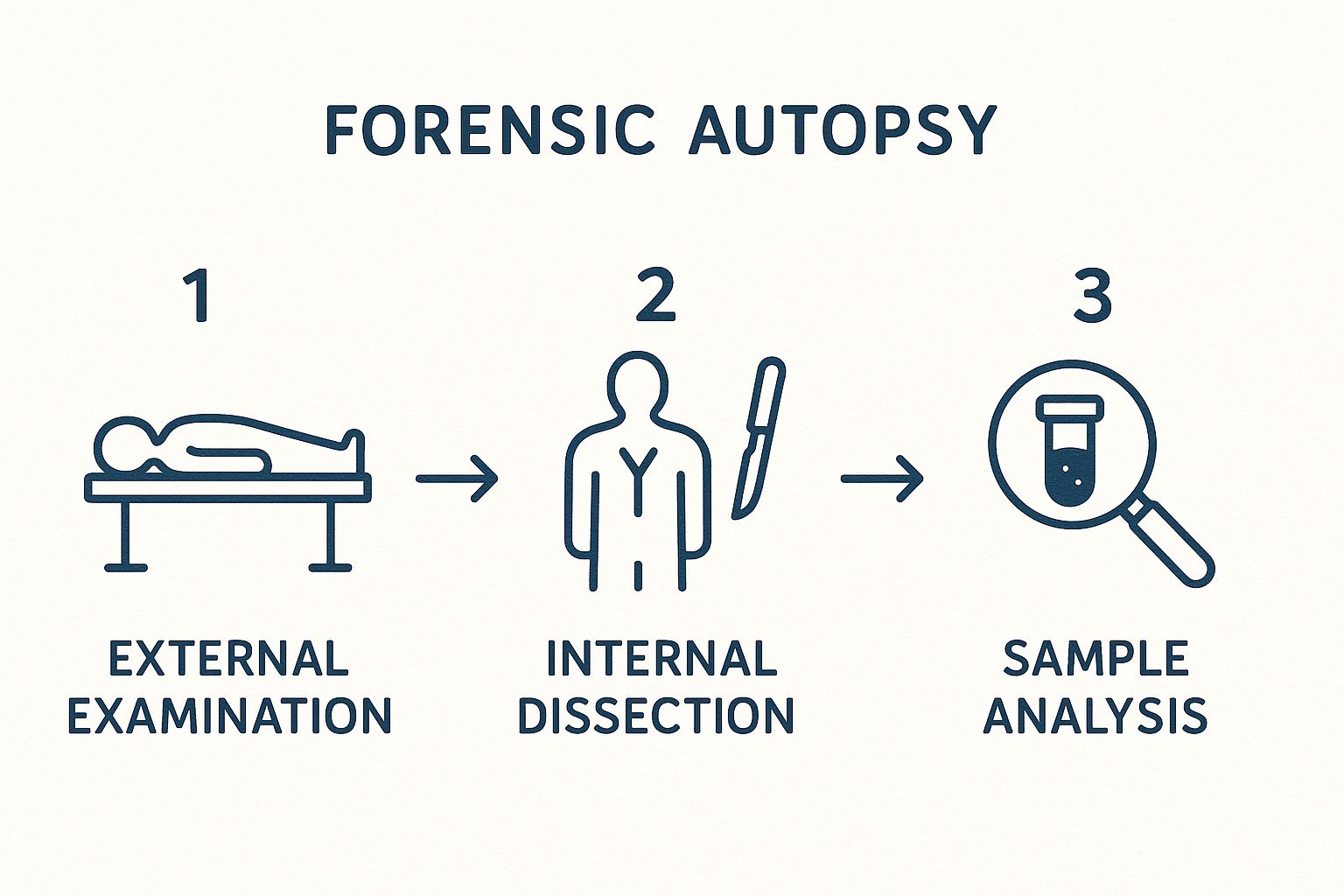
This step-by-step progression is crucial. Each phase builds on the one before it, helping create a comprehensive and accurate picture of what happened.
The External Examination
The very first step is the external examination, which is a thorough, head-to-toe inspection of the body's surface. Think of it as creating a detailed map before exploring a new territory. Nothing is invasive at this point; it is all about observation.
This is far more than a quick look. It involves:
- Detailed Photography: A permanent visual record of the body is created exactly as it was received.
- Identification: We carefully note identifying features like scars, tattoos, or birthmarks and record height and weight.
- Clothing Examination: If the person is clothed, we examine the garments for any trace evidence before they are respectfully removed.
- Injury Documentation: We meticulously document any signs of injury—from the most apparent to the most subtle—measuring them and describing their specific characteristics.
This initial phase provides a critical baseline and often gives us major clues about the circumstances of the death before we even begin the internal portion of the exam.
The body itself is the most important piece of evidence in a death investigation. Our first responsibility is to observe and document its story with precision, ensuring that no detail, however small, is overlooked.
The Internal Examination and Ancillary Studies
After the external review is complete, we move on to the internal examination. This is where we systematically evaluate the internal organs to find any disease, injury, or abnormality that was not visible from the outside.
We examine each organ system in a specific, methodical order to ensure nothing is missed. This systematic approach is a cornerstone of modern forensic pathology. It's a practice built on the work of historical pioneers like Karl Rokitansky, who conducted over 30,000 autopsies, and Rudolf Virchow, who introduced cellular pathology. You can learn more about how these historical figures shaped the autopsy process.
During this phase, we also collect small tissue samples and bodily fluids for what we call ancillary studies. These tests are absolutely vital for a complete investigation.
They typically include:
- Toxicology: This analysis screens for the presence of alcohol, prescription drugs, illegal substances, or poisons. It is critical for determining if substances played a role in the death.
- Histology: We take tiny tissue samples, place them on microscope slides, and examine them at a cellular level. This allows us to see diseases or microscopic injuries invisible to the naked eye.
- Microbiology: If we suspect an infection contributed to the death, cultures may be taken to identify the specific bacteria or viruses responsible.
To better understand how these stages fit together, the following table breaks down the process.
Phases of a Forensic Autopsy
This table summarizes the major stages of the forensic autopsy process and the key objectives of each phase.
| Phase | Objective | Examples of Procedures |
|---|---|---|
| External Examination | Document the body's surface condition and identify evidence. | Photography, measuring height/weight, noting scars/tattoos, examining clothing. |
| Internal Examination | Assess internal organs for injury, disease, or abnormalities. | Systematic dissection and inspection of organ systems (e.g., heart, lungs, brain). |
| Ancillary Studies | Gather microscopic and chemical data for a complete picture. | Toxicology, histology (microscopic tissue analysis), microbiology cultures. |
These ancillary studies are often what take the most time, but they are absolutely necessary. They provide a depth of information that a physical examination alone cannot, making sure our final conclusions are built on a solid foundation of scientific data. It is this powerful combination of the big picture and the microscopic details that makes what is a forensic autopsy such an effective tool for finding the truth.
Understanding the Final Autopsy Report
Once the physical examination is complete and all laboratory tests are returned, everything comes together in one crucial document: the final autopsy report. This is not just a summary; it is the official, scientific narrative of the entire investigation. For families and legal teams, this report is the key to getting the definitive answers they have been waiting for.
Think of it as the final word on the medical facts of the case. It is a detailed, formal narrative that pulls together every piece of information into a clear conclusion. Because it serves as a permanent legal record for court cases, insurance claims, and settling estates, every detail must be precise and factual.
What's Inside the Report?
While every case is unique, all reports follow a standard structure to ensure they are clear and complete. Knowing what to look for can make this document much less intimidating.
You'll typically find these key sections:
- Final Diagnoses: This is the bottom line. It clearly states the official cause of death (the specific injury or disease that led to death) and the manner of death (which falls into one of five categories: natural, accident, suicide, homicide, or undetermined).
- Narrative Summary: This is a brief overview of the case, including the circumstances surrounding the death and a rundown of the most important findings from the examination.
- Detailed Findings: Here, I document everything observed during the external and internal examinations, system by system. I note what is normal just as carefully as I note any abnormalities or injuries.
- Lab Results: This section contains the complete reports from toxicology, histology (microscopic tissue analysis), and any other specialized tests that were performed.
The final report is built to be an objective and comprehensive account. Its job is to present the unvarnished scientific truth, providing the clarity needed for legal resolution and the answers a family deserves.
When to Expect the Report and How to Get It
One of the first questions families ask is, "When will we get the report?" It's a completely fair question. While the hands-on part of the autopsy is usually finished in a day, compiling the final report often takes much longer. The delay is almost always due to the specialized lab tests.
Toxicology screens and microscopic tissue analysis are incredibly detailed and simply take time—sometimes several weeks or even months. I cannot issue a final, conclusive report until every single piece of data is back and has been carefully reviewed. Rushing this step could lead to mistakes, and that is a risk we can never take.
In Texas, the autopsy report is a legal document. The legal next-of-kin or a representative of the estate is usually the one who can request a copy. This is often done through the Justice of the Peace or Medical Examiner's office that authorized the autopsy. It's a sensitive document, so its release is handled carefully and according to procedure. Knowing this from the start helps set realistic expectations and gives families the information they need to move forward.
When to Consider a Private Forensic Autopsy
There are times when the authorities do not order a legally required autopsy, yet a family is still left with nagging doubts and unanswered questions. When that happens, a private forensic autopsy can be a powerful tool for getting the clarity and peace of mind you deserve.
This is especially common when a loved one passes away at home, in a hospital, or a nursing home from what are assumed to be natural causes, yet something about the situation does not feel right. Families also turn to us when they suspect medical malpractice might have played a role, or even when they simply want a second expert opinion on an official cause of death.
Taking Control of the Narrative
Opting for a private autopsy puts you and your family back in control of the investigation. It is a process initiated by you, not a government agency, which means you get direct communication and compassionate guidance every step of the way.
We approach every private examination with the same level of scientific precision and meticulous detail as a medical examiner's office. The only difference is that the final, comprehensive report goes directly to you, your family, or your attorney.
A private forensic autopsy provides an independent, objective investigation focused solely on answering a family’s specific questions. It is a path to definitive answers when official channels do not provide them.
Ultimately, this is about reclaiming a sense of control during an incredibly difficult and confusing time. It is about getting the scientific facts you need to truly understand what happened to your loved one.
To get a better idea of what's involved, you can read our guide on the typical cost of a private autopsy.
Common Questions About Forensic Autopsies
When a loved one passes away unexpectedly, the grief is often overwhelming. In the middle of that, practical questions about what comes next can feel just as heavy. Over the years, I've found that families often have the same pressing concerns about the autopsy process. Let's walk through some of the most common ones.
Will an Autopsy Prevent an Open-Casket Funeral?
This is, understandably, a significant worry for many families. I can provide reassurance that the answer is almost always no.
A board-certified forensic pathologist performs every examination with profound respect for the deceased. We are trained to make incisions in a way that they will not be visible once a person is dressed for a viewing. Our work is meticulous and always considerate of your family's wishes for a final goodbye, including an open-casket service.
What Is the Difference Between Cause and Manner of Death?
These two terms sound similar, but they answer very different questions. Understanding both is key to understanding what a forensic autopsy truly accomplishes.
- Cause of Death: This is the medical reason a person died—the specific injury or disease that initiated the chain of events leading to death. Examples include a "gunshot wound to the head" or an "acute myocardial infarction," the clinical term for a heart attack.
- Manner of Death: This is the legal classification of how the death occurred. There are only five official categories: natural, accident, suicide, homicide, and undetermined.
The forensic autopsy is the scientific process that gathers the physical evidence needed to determine both the cause and manner of death with clarity and confidence.
How Long Does It Take to Get Final Autopsy Results?
While the physical examination itself is typically completed within a day, receiving the final, complete report takes longer. We often must wait for specialized lab results to come back.
Additional tests, like toxicology to check for drugs or substances, and histology, where we examine tissues under a microscope, are essential for a complete picture. These analyses can take several weeks or sometimes longer. A preliminary report might be available sooner, but the comprehensive final report is only issued after every piece of data has been received and carefully analyzed. We do this to ensure total accuracy for your family and for the legal record.
If you have more questions or feel a private autopsy could provide the answers your family is searching for, the team at Texas Autopsy Services is here to help. We are committed to providing guidance with compassion and professionalism. Please do not hesitate to call or email our office to discuss your situation.
You can find more information on our Texas Autopsy Services website.
